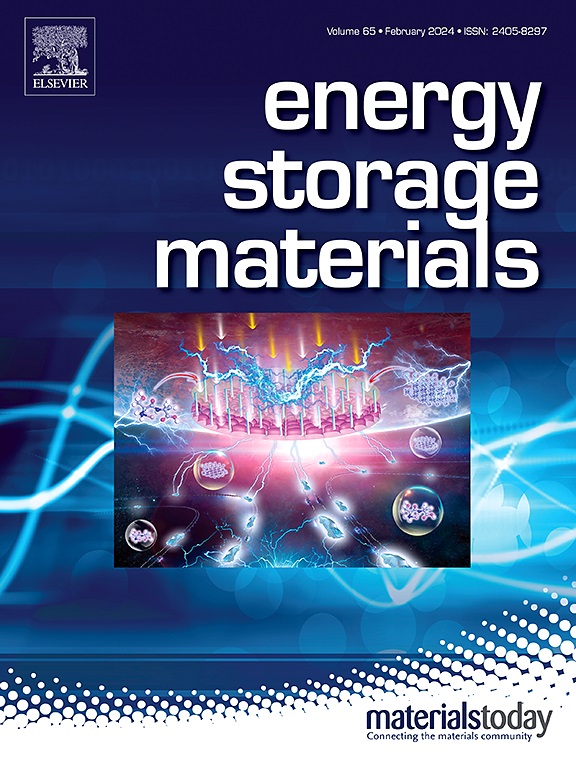超低自旋电极同时实现超长寿命和高倍率性能的锌碘电池
IF 20.2
1区 材料科学
Q1 CHEMISTRY, PHYSICAL
引用次数: 0
摘要
增强的碘氧化还原化学和碘离子锚定对锌碘(Zn-I2)电池的发展起着决定性的作用,但以目前的策略来满足应用需求仍然是一个主要的挑战。在这项工作中,通过将单分散的Zn原子掺入单个Ni原子周围,将Ni自旋状态从高自旋改变为低自旋。实验和理论分析表明,低自旋态优化了Ni和I原子之间的d-p轨道杂化,减少了Ni-I偶联轨道的反键电子占用。低自旋态增强了碘种氧化还原转化动力学,防止了碘种的猖獗穿梭。因此,长寿命(30,000次循环后容量保持70%)和高倍率性能同时实现,袋状电池在2 a g-1下循环500次后保持164 mAh g-1的容量。这种ni自旋态控制策略激发了人们对催化和氧化还原转换储能领域中催化活性-电子结构关系的更深入理解。本文章由计算机程序翻译,如有差异,请以英文原文为准。
Ultra-long life and high rate performance zinc-iodine batteries simultaneously enabled by a low-spin electrode
Enhanced iodine redox chemistry and iodine species anchoring play a determining role in the advancement of zinc-iodine (Zn-I2) batteries, and it remains a major challenge to meet the application requirements with current strategies. In this work, the Ni-spin state is altered from high spin to low spin through the incorporation of monodispersed Zn atoms surrounding individual Ni atoms. The experimental and theoretical analyses reveal that the low-spin state optimizes the d-p orbital hybridization between Ni and I atoms, reducing the antibonding electron occupation of the Ni-I coupling orbitals. The low-spin state enhances the iodine species redox conversion kinetics and prevents rampant iodine species shuttling. Consequently, long-life (70 % capacity retention after 30,000 cycles) and high rate performance are simultaneously achieved, with the pouch cell maintaining a capacity of 164 mAh g-1 after 500 cycles at 2 A g-1. This Ni-spin state control strategy inspires a deeper understanding of catalytic activity-electronic structure relationships in the fields of catalysis and redox conversion energy storage.
求助全文
通过发布文献求助,成功后即可免费获取论文全文。
去求助
来源期刊

Energy Storage Materials
Materials Science-General Materials Science
CiteScore
33.00
自引率
5.90%
发文量
652
审稿时长
27 days
期刊介绍:
Energy Storage Materials is a global interdisciplinary journal dedicated to sharing scientific and technological advancements in materials and devices for advanced energy storage and related energy conversion, such as in metal-O2 batteries. The journal features comprehensive research articles, including full papers and short communications, as well as authoritative feature articles and reviews by leading experts in the field.
Energy Storage Materials covers a wide range of topics, including the synthesis, fabrication, structure, properties, performance, and technological applications of energy storage materials. Additionally, the journal explores strategies, policies, and developments in the field of energy storage materials and devices for sustainable energy.
Published papers are selected based on their scientific and technological significance, their ability to provide valuable new knowledge, and their relevance to the international research community.
 求助内容:
求助内容: 应助结果提醒方式:
应助结果提醒方式:


